Where: A hand-written note stuck on the back of the photo explains where the photo was taken:
"Quarry men who excavated site for Taikoo Dockyard
N.B. The man with the gong who beat it to warn workers the blasts were about to [???].
N.B. also all with pigtails!
Hongkong - Quarry Bay 1907-8"
Who: As usual, there are several ways to ask this question. We'll start with the obvious one.
Who we can see in the photo?
As the note says, these are some of the men who worked on the excavations for the Taikoo Dockyard project. They'd have started by cutting away the hillside, creating the flat land that would become the site of the new Dockyard.
After that, additional excavation was needed to dig the deep, wide channel that would become the dry dock. Warren Swire's photos include one taken soon after that second excavation was complete. The bottom of the dry dock has already been lined, and lining the sides is in progress.
Another of his photos, taken a few years later, shows how it looked when it was finished.
Here's the star of the group:
The man with the gong had a very important job, as the workers depended on his warnings to move to safety before blasting took place. Barbara Anslow remembers experiencing gongs and blasting at Morrison Hill in the 1920s:
"Our only excitement was watching blasting operations on Morrison Hill. All day long, dark-clad coolies - men and women - were chipping and hacking away on the site in preparation for blasting. At noon and at 5pm loud gongs would warn that blasting was imminent; we watched in fascination for the puffs of smoke, the explosions, and the flurry of chippings that flew far and wide."
That extra responsibility probably translated into extra pay, as the gong man is one of the few people wearing enclosed shoes. The others wear wooden clogs, or go barefoot.
Though the caption says "Quarry men", the group also included several children - two can be seen standing next to the man with the gong, and on his other side is an even smaller child, peeping out from behind the gong and the man wearing the sleeveless top.
Barbara's note suggests there may also have been girls or women working here. Most of the people have the queue (long braid of hair) and shaved forehead, which was the standard haircut for Chinese men at the time. Possibly some of the group wearing hats were women - eg these two at the back.
Who took the photograph?
The name is embossed into the card surround that the photo is mounted on.
Terry Bennett has previously explained that Pun Lun was the name of a photographic studio rather than a person, and noted that the studio opened in Hong Kong in 1864. It was clearly a success, as by the time this photo was taken, the studio had been in business for over 40 years.
Who owned this photograph?
Fortunately, this photo is one of a pair, and the second photo has a note on the back in the same handwriting:
"European Construction Staff for Taikoo Dockyard Quarry Bay 1907.
Note everyone with a topee!
Mr A. G. Cooper later became my husband - having previously to H.K worked on dockyards Cardiff & Gibraltar."
The 1907 Jurors List doesn't mention any A G Cooper, but he's there in the lists for 1908 and 1909:
| c | Cooper | Albert George Warner Inerd | Civil Engineer | Butterfield & Swire | On premises |
In another stroke of luck, he has an unusual name, which makes searching the internet much easier. The first match is a family tree, which says he married Bertha Murray Watt. So there are the initial owners of the photographs, Albert and Bertha.
The family tree also mentions that Albert was later Manager of the Paraguay State Railways. Looking at those railway lines in the photo above, it's tempting to wonder whether this was the project that kindled an interest in railways? In any case, he must have felt that three dockyards were enough, as his obituary says he moved to South America in 1910. His started with the Great Western Railway of Brazil, then in 1928 he moved to the Paraguay Central Railway. He stayed there until 1944 when he returned to England, giving poor health as the reason for leaving. He died in 1949, aged 67.
What: Returning to the men and their hairstyle, I've read that during the Qing dynasty, men were required to shave their foreheads. But how long could you let the hair on the forehead grow before you'd get into trouble? Several of these men clearly didn't take the rule too seriously, as their foreheads show a couple of weeks' growth already.
When: Bertha dates the photo to 1907-8, which is likely the period that her husband Albert was in Hong Kong. The dry dock was first filled with sea water in June 1907, suggesting the quarrying work was pretty much done by then. The photos may have been taken to commemorate the end of the project.
Thanks: Many thanks to Deirdre and Ken Locke, who very kindly gave me this photograph, and several other interesting old Hong Kong photographs. Deirdre and Ken acquired them in the 1970s, when they were both working in Hong Kong - Deirdre taught at Victoria Barracks and the English Schools Foundation, and Ken lectured at the HK Polytechnic. They live in Australia now, but still visit Hong Kong regularly.
Gwulo Photo ID: NJ001
Further reading:
- Photos of the Taikoo Dockyard
- Excavating Morrison Hill
- Farewell to the queue, the Qing dynasty men's hairstyle
- Paraguay State Railways were unsual for continuing to run steam engines in to the 21st-century, fuelled by wood. Here's a slide show of what's left, and some information about the line.
- And there are lots more old Hong Kong photos and stories in the Gwulo books, volume 1 and volume 2.
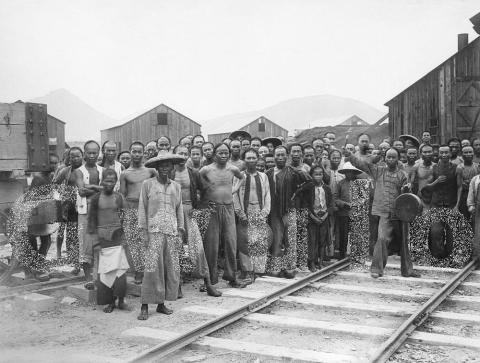
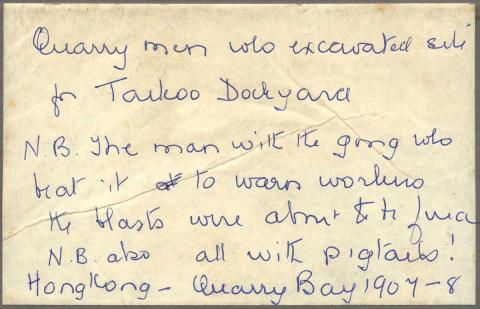


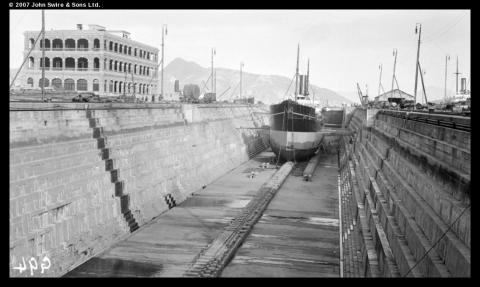
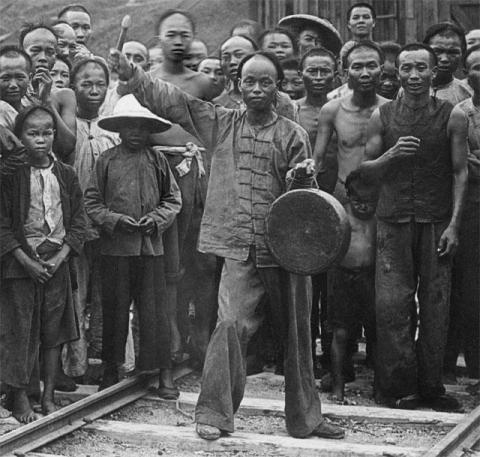

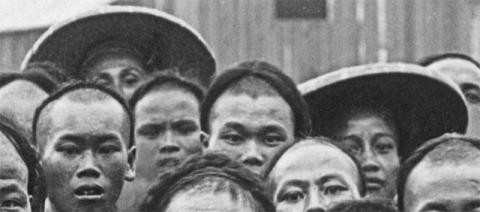

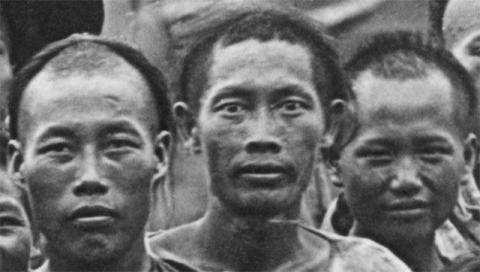
Comments
The beating of gongs
p.p1 {margin: 0.0px 0.0px 0.0px 0.0px; font: 11.0px Times}
There is still a requirement under the Dangerous Goods (General) Regulations (Cap. 205B) for beating a gong prior to firing a blast. Under regulation 55(1) (c), when a blast is carried out: "for a period lasting from 5 minutes prior to the blasting until all charges have been fired, warning gongs shall be beaten continuously so as to be audible at a distance of 150 m therefrom and red flags shall be displayed continuously at all points of access to the place of blasting and at a distance of 150 m from such place". As far as I am aware, we are the only place where there is a extant legal requirement to beat a gong. Somethings take a while to change in Hong Kong.
Note on the back
i think it says “..... the blasts were about to fire”
Note on the back
about to be fired
Thanks for the replies. I
Thanks for the replies. I agree that unclear word is likely some version of "fire". And it's good to hear the man with a gong is still in business today!
Regards, David
Men wearing “queues”
I note that the writer uses the term “pigtails.”
I imagine that in the early 20th century, such a term was acceptable. It would NOT be acceptable now. In fact, it would be grossly offensive. The proper term is “queue.” The Manchu Qing (Ching) rulers required all Chinese males to wear the queue - something the HK Government viewed as acceptable.
Swire's “Believe in Hong Kong” Exhibition
The photograph of the quarry workers at the new Taikoo dockyard is currently on display at Swire's "Believe in Hong Kong" exhibition at Cityplaza Taikoo Shing. The exhibition, which finishes tomorrow, 6 November, is well worth a visit as it covers the long history of Butterfield and Swire, now known as Swire, in Hong Kong.